Father Adrien de Montaubricq came from Bordeaux, France, to America in the last century to work among the French Canadian immigrants. In 1869, at the request of Archbishop John Williams of Boston, he came to Fall River to organize a French parish with some 3,000 Canadian immigrants already here. He began without delay to build a church that he dedicated to Saint Anne. A sizable wooden structure with a large basement that served as a parish hall, then also provided space for a few classrooms. Here was the first Saint Anne School.

At first it was only a Sunday school, with Sisters of Jesus-Mary, from the Flint section of the city, teaching catechism. Then, Sisters of Mercy, who resided closer by and fortunately had two Sisters of French-Canadian origin, took over and provided the staff for a “day school.”
In the summer of 1883, the pastor, Father Briscoe, a native of Ireland who had studied in France and spoke French fluently, went to Montreal and obtained several Sisters of Holy Cross to occupy and staff a new convent school he had built.
In 1891, the Dominican Fathers from Canada, now in charge of St Anne Parish, manifested a special concern for the education of their children. To accommodate the increasing number of children in their parish, they built a more substantial school, a red brick building, with auditorium, that they saw with pride as comparing favorably with the fine public schools of Fall River.
To respond to the ever growing needs of the French population, spread across a large portion of the city, many other schools and classrooms were set up in different sections of the parish. Dominican Sisters were later added to the teaching staff, and still later, Brothers of Christian Schools to teach the boys.
The Brothers taught the elementary grades, then later opened a “commercial” or “business” school. This “Commercial College” was taught in both French and English and earned a reputation for excellence.
Immigration from Quebec continued, moving the pastors of St Anne to plan for a large, centralized school providing 33 classrooms, besides two kindergartens, and a magnificent auditorium with a seating capacity of 1,200. This impressive central school opened in September of 1925. The parish census for 1926 reported 1,559 children enrolled in the school.
Around 1926, there started a steady decline in the population of the city, due to an industrial crisis. Numerous families left Fall River. The parish population, as well as the school attendance, declined steadily in the years that followed. That was before the Great Depression of the 1930s.
The financial status of Fall River, with no major industry, has been fragile to this day. Needless to say that the weakness of the economy of our city has had an adverse effect on our families, our parishes and our schools.
